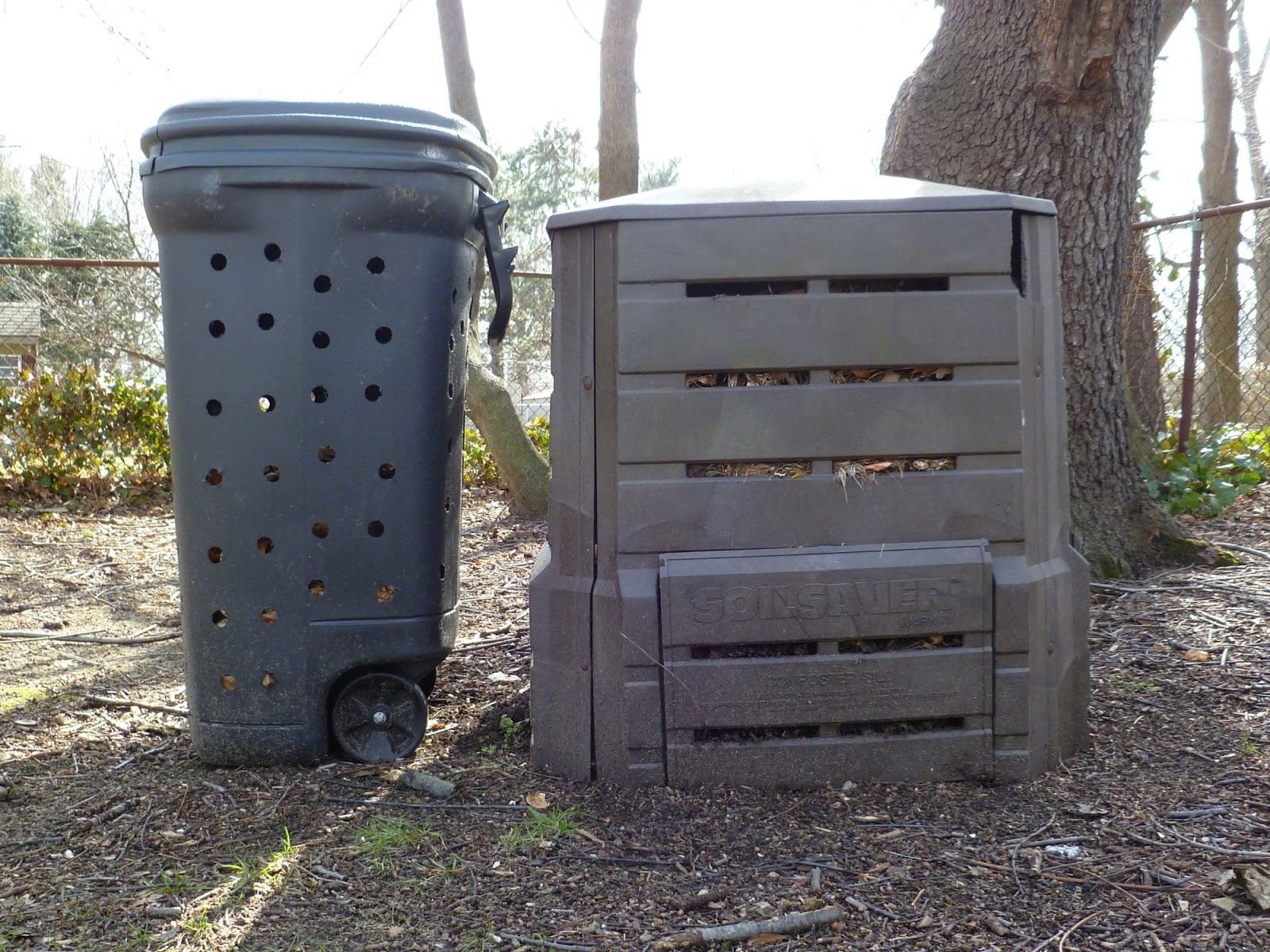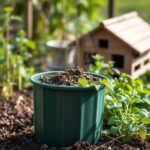Can I Compost in a Garbage Bin? Your Ultimate Guide to Composting Basics

Composting is a sustainable practice that transforms kitchen scraps and yard waste into nutrient-rich soil, benefiting both gardens and the environment. However, many wonder if they can effectively compost using a simple garbage bin. This guide will explore the essentials of composting, debunk common myths, and provide practical tips for successful composting in a typical trash container. Whether you're an experienced gardener or just starting your composting journey, understanding the basics will help you create a thriving compost system that reduces waste and enhances your gardening efforts. Dive into the world of composting and discover how to make it work for you!
Can I Compost in a Garbage Bin?
Yes, you can compost in a garbage bin, but it's essential to ensure that the bin is suitable for composting and not just a regular waste container. Using a garbage bin for composting allows you to create a closed environment where organic materials can decompose effectively. However, you must manage the bin properly by ensuring adequate aeration and moisture levels to promote the decomposition process. Keeping a balance between green materials (like fruit scraps) and brown materials (such as dry leaves) is also crucial. Make sure not to include meat, dairy, or oils in your compost bin, as these can attract pests and create odors. Additionally, rotating the compost or turning it occasionally can help speed up the breakdown of organic materials.
Choosing the Right Type of Bin
Selecting the proper type of bin for composting is vital. Ideally, a bin should have sufficient ventilation to allow for airflow, which is necessary for aerobic decomposition. While some opt for traditional compost bins, others may choose a simple plastic or metal garbage bin with small holes drilled into it for aeration. It's critical to consider the size of your compost bin; larger bins accommodate more material, but small bins can be easier to manage, especially for beginners.
What Can Be Composted?
When composting in a garbage bin, it's important to know what can be included. Suitable items are known as greens and browns. Greens include kitchen scraps like vegetable peels, fruit cores, and coffee grounds, while browns consist of dried leaves, cardboard, and paper. Avoid items like meat, dairy, and oils, as they can lead to smell and pest issues. Maintaining diversity in your compost ingredients fosters a stronger decomposition process and enriches the final compost output.
Maintenance of the Compost Bin
Maintaining your compost bin is critical for a successful composting process. Ensure that the compost stays moist, resembling a damp sponge, and turn it regularly to aerate the mixture. This process not only prevents odor but also speeds up decomposition by distributing microorganisms throughout the compost. Keeping the right balance between green and brown materials is essential; too many greens can create a soggy, smelly mess, while too many browns can slow down the breakdown process.
Common Problems and Solutions
When composting in a garbage bin, you may encounter issues such as unpleasant smells or pests. If your compost smells bad, it might be too wet or lacking oxygen; adding more browns and aerating the pile can often resolve this. Pests can be deterred by maintaining a good mixture and avoiding inappropriate items like meat. If you notice pests, consider placing the bin in a shaded area and burying food scraps under the compost material to minimize exposure.
Recipes for Successful Compost
Creating a successful compost involves understanding the right proportions of greens and browns. An ideal mixture might follow the ratio of 2:1, with two parts browns to one part greens. This approach helps maintain the right moisture and ensures proper aeration. A simple recipe could include the following: add coffee grounds, fruit scraps, dried leaves, and shredded paper. By alternating layers of greens and browns, you help create a balanced and effective compost blend.
| Material Type | Examples | Category |
|---|---|---|
| Greens | Vegetable scraps, fruit peels, coffee grounds | Rich in nitrogen |
| Browns | Dried leaves, cardboard, paper | Rich in carbon |
| Avoid | Meat, dairy, oils | Can attract pests |
How to turn a garbage bin into a compost bin?

To transform a standard garbage bin into an efficient compost bin, you will need to follow several steps that involve preparation, modification, and maintenance. Composting is a sustainable practice that allows organic waste to decompose naturally, creating nutrient-rich soil for gardening and landscaping. Here’s how you can do it:
Choosing the Right Garbage Bin
Selecting an appropriate garbage bin is the first step in this conversion. The size and material will significantly impact the composting process.
- Material: Opt for a bin made of durable plastic or metal. Make sure it can withstand outdoor elements.
- Size: A bin that holds at least 30 gallons is ideal for effective composting.
- Accessibility: Ensure the bin has a lid to keep pests out, but can still be opened easily for adding materials.
Preparing the Garbage Bin
Before using the garbage bin for composting, some modifications are necessary to enhance airflow and drainage.
- Drill Holes: Using a drill, create several holes in the sides and bottom of the bin. This allows air to circulate and moisture to escape.
- Line the Base: Place mesh or wire mesh at the bottom to prevent soil from washing out while allowing drainage.
- Keep it Covered: Ensure the lid can be secured tightly to keep out pests while still allowing for ventilation.
Adding Compostable Materials
Once your compost bin is set up, you can begin adding organic waste, which is critical for the composting process.
- Green Materials: Include nitrogen-rich materials such as fruit and vegetable scraps, coffee grounds, and grass clippings.
- Brown Materials: Add carbon-rich items like dried leaves, cardboard, and newspaper to balance moisture and aeration.
- Avoid Additives: Do not add meat, dairy, or oils, as they attract pests and create odors.
Maintaining Your Compost Bin
Regular maintenance is crucial to ensure effective composting and to facilitate the breakdown of materials.
See also:
- Turn the Pile: Every few weeks, use a pitchfork to turn the compost. This aeration speeds up the decomposition process.
- Monitor Moisture: Ensure the compost stays damp but not soaked. A consistency similar to a wrung-out sponge is ideal.
- Check Temperature: Compost piles should reach a temperature of 130-160°F. This helps kill pathogens and pests.
Harvesting Compost
After a few months, your compost should be ready to use. Knowing when and how to harvest it is essential for getting the best results.
- Color and Texture: Look for dark, crumbly soil that smells earthy. This indicates that the compost is ready.
- Screening: Use a sieve to filter out larger chunks that need more time to break down.
- Use in Gardens: Mix the finished compost into your garden soil or use it as a top dressing for plants.
Can I compost in a bin?

Yes, you can compost in a bin. Composting in a bin is an effective way to turn organic waste into nutrient-rich compost while minimizing unpleasant odors and pests. Compost bins provide an enclosed space that helps to maintain the right conditions for decomposition. By containing materials, compost bins also help to streamline the process and can make it easier to manage and monitor your composting efforts.
Benefits of Composting in a Bin
Composting in a bin offers several advantages that can enhance the composting process:
- Pest Control: Bins can deter pests, such as rodents and insects, which might be attracted to compost piles left open.
- Odor Management: An enclosed space helps to contain odors that can be produced during decomposition.
- Temperature Regulation: Compost bins can help maintain the ideal temperature for decomposition by insulating the materials inside.
Types of Compost Bins
There are various types of compost bins available to suit different needs and preferences:
- Traditional Wooden Bins: These bins are often made from pallets and can be customized to fit your backyard space.
- Plastic Tumblers: Designed for easy mixing, these bins allow users to turn the compost frequently for aeration.
- Worm Bins: Also known as vermicomposting systems, these specifically use worms to break down organic matter quickly.
What Can Be Composted in a Bin?
Not all materials are suitable for composting, even in a bin. Here is a list of compostable items:
- Food Scraps: Fruits, vegetables, coffee grounds, and eggshells are excellent additions.
- Yard Waste: Grass clippings, leaves, and small branches are great for adding carbon to your compost.
- Paper Products: Shredded newspaper and cardboard can help balance the carbon-nitrogen ratio.
How to Set Up a Compost Bin
Setting up a compost bin is straightforward. Follow these steps to get started:
- Choose a Location: Find a dry, shaded spot in your yard that's accessible for adding materials and turning the compost.
- Select Your Bin: Purchase or build a bin that suits your space, budget, and personal style.
- Add Materials: Layer green materials (nitrogen-rich) with brown materials (carbon-rich) to create balance.
Tips for Successful Composting
To ensure your composting process is successful, consider the following tips:
- Turn Regularly: Aerate your compost by turning it every few weeks to promote decomposition.
- Monitor Moisture Levels: The compost should be moist but not soggy; adjust as needed with water and dry materials.
- Avoid Contaminants: Do not add meat, dairy, or oils to your compost, as these can attract pests and create foul odors.
What is the laziest way to compost?

The laziest way to compost is often referred to as lazy composting, which involves minimal effort and maintenance while still allowing organic waste to decompose naturally. This method can be ideal for those who want to reduce waste without dedicating too much time or energy to traditional composting practices.
What is Lazy Composting?
Lazy composting is a method of composting that requires little to no active management. Unlike traditional composting, where turning the pile and balancing greens and browns is necessary, lazy composting allows organic materials to break down in their own time, often directly on the ground or in a designated area without much interference.
- Less Turning: Unlike regular composting, there's minimal need to turn the pile.
- Natural Decomposition: Organic materials are left to decompose naturally over time.
- Set and Forget: You can add materials as you go and let nature do the work.
How to Start Lazy Composting
Starting lazy composting involves choosing the right location and materials. Identify a designated area in your yard, preferably a spot that gets some sunlight but is not overly exposed to harsh winds. Simply begin adding kitchen scraps and yard waste directly to this area without worrying about layering or maintaining a specific balance of materials.
- Select a suitable spot in your garden or yard.
- Gather kitchen scraps like vegetable peels, coffee grounds, and eggshells.
- Add garden waste such as grass clippings, leaves, and small branches.
What Materials Can Be Used?
A variety of organic materials can be used in lazy composting, which contributes to the richness of the final compost. The most common materials include both kitchen and garden waste. It’s important, however, to avoid adding meat, dairy, or oils to prevent unpleasant odors and pest issues.
See also:
- Kitchen scraps like fruit and vegetable peels and leftover foods.
- Garden waste such as leaves, grass clippings, and small branches.
- Cardboard and paper products, provided they are free of inks and chemicals.
Benefits of Lazy Composting
Lazy composting comes with several benefits that appeal to both novice and experienced gardeners. Since it requires minimal effort, this method allows individuals to participate in composting without the time commitment associated with more structured methods. Additionally, it contributes to reducing landfill waste and provides nutrient-rich compost for your garden.
- Minimal time and effort required for setup and maintenance.
- Reduces waste sent to landfills, promoting sustainability.
- Results in rich compost that can improve soil health and fertility.
Pitfalls to Avoid with Lazy Composting
While lazy composting is relatively easy, there are some pitfalls that one should be aware of to ensure success. Overloading the compost site with too much material at once can lead to unpleasant odors and attract pests, while not incorporating enough brown materials can slow down decomposition.
- Avoid adding too much high-moisture content material in one go.
- Be cautious of odors; if they arise, consider adding more dry materials.
- Ensure the pile isn’t too dense, allowing for proper airflow and decomposition.
Can I compost in a garbage bag?

Composting in a garbage bag is generally not recommended as a viable method for several reasons. While it might seem convenient to throw kitchen scraps and yard waste into a garbage bag to decompose, traditional composting involves a process that requires adequate air circulation, moisture, and the right balance of materials. Garbage bags can impede this process, resulting in less effective decomposition. Here’s a detailed exploration of this topic.
Understanding the Composting Process
Composting is a natural biological process where microorganisms break down organic matter into rich soil. For successful composting, several key factors need to be present:
- Airflow: Compost needs oxygen to facilitate the decomposition process; sealed bags restrict airflow.
- Moisture: The right level of moisture is essential; too moist or too dry conditions can hinder microbial activity.
- Material Balance: A proper ratio of nitrogen-rich greens and carbon-rich browns is required; bags can lead to an uneven mix.
Challenges of Composting in Garbage Bags
Using garbage bags for composting poses numerous challenges that can prevent effective decomposition:
- Odor Control: Sealed garbage bags can trap odors and create an unpleasant smell due to anaerobic decomposition.
- Temperature Regulation: A compost pile generates heat, which is necessary for killing pathogens; garbage bags do not support this heating process.
- Leakage Issues: Bags can often leak and can be challenging to manage if liquid accumulates improperly.
Alternative Methods for Composting
Instead of using garbage bags, consider these alternative composting methods that support the natural process:
- Compost Bins: Use specially designed bins that allow for airflow while containing organic materials.
- Pile Composting: Simply pile organic waste in a designated area, ensuring to turn it periodically to enhance aeration.
- Tumbling Composters: These rotating containers ensure proper mixing and aeration, speeding up the composting process.
Composting Tips and Best Practices
If you decide to compost, following these tips can greatly improve your results:
- Maintain a Balanced Ratio: Aim for a mix of 2:1 browns (carbon) to greens (nitrogen).
- Turn Your Pile: Regularly aerate your compost by turning it to promote decomposition.
- Monitor Moisture Levels: Ensure the compost is damp but not soggy; it should feel like a wrung-out sponge.
Disposing of Waste in Garbage Bags Properly
If composting in garbage bags isn't ideal, consider these proper waste disposal strategies for your organic materials:
- Municipal Composting Programs: Check if your community has a curbside compost collection service.
- Home Composting Systems: Invest in a home composting system that fits your space and needs.
- Compostable Bags: If bagging is necessary, look for compostable bags that break down in compost environments.
Questions from Our Readers
Can I compost in a garbage bin?
Yes, you can compost in a garbage bin, but it requires a few modifications to ensure proper aeration and drainage. It's important to use a bin that allows air to circulate and to add a mix of green and brown materials to create a balanced compost.
What materials can I compost in a garbage bin?
You can compost a variety of organic materials in a garbage bin, including fruit and vegetable scraps, coffee grounds, eggshells, and yard waste. However, avoid adding meat, dairy, and oily foods, as they can create odors and attract pests.
How do I maintain compost in a garbage bin?
To maintain your compost in a garbage bin, regularly turn the contents to ensure proper aeration and moisture levels. Keep the compost moist, but not too wet, and monitor the temperature to ensure that it remains within the optimal range for decomposition.
Can I use a regular garbage bin for composting?
While you can use a regular garbage bin for composting, it's advisable to modify it for better results. Consider drilling holes for air circulation and adding a layer of drainage at the bottom to prevent sogginess, which can inhibit the composting process.
See also:

If you want to read more articles like Can I Compost in a Garbage Bin? Your Ultimate Guide to Composting Basics, we recommend you check out our Compost category.
Leave a Reply
Related Articles